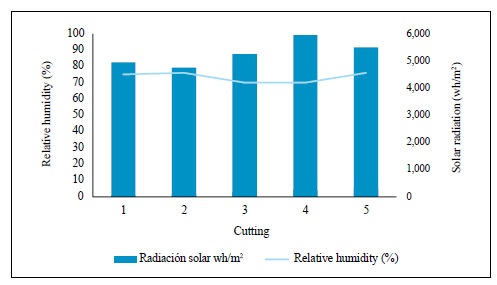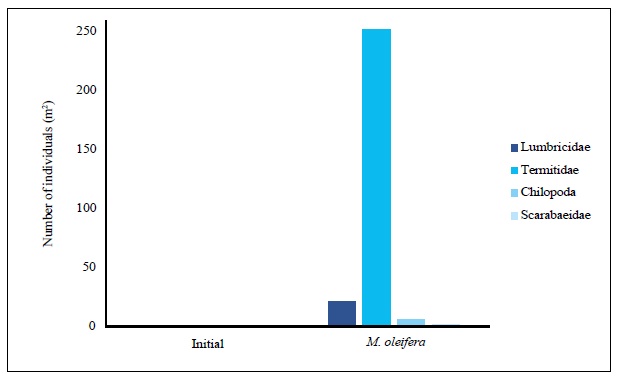Serviços Personalizados
Journal
Artigo
Indicadores
-
 Citado por SciELO
Citado por SciELO -
 Acessos
Acessos
Links relacionados
-
 Citado por Google
Citado por Google -
 Similares em
SciELO
Similares em
SciELO -
 Similares em Google
Similares em Google
Compartilhar
Ciencia y Tecnología Agropecuaria
versão impressa ISSN 0122-8706versão On-line ISSN 2500-5308
Cienc. Tecnol. Agropecuaria vol.20 no.2 Mosquera maio/ago. 2019
https://doi.org/10.21930/rcta.vol20num2art:1457
Alimentación y nutrición animal
Fodder banks of Moringa oleifera under tropical humid forest conditions
1Docente, Universidad de La Salle, Facultad de Ciencias Agropecuarias. Bogotá, Colombia
2Corporación Colombiana de Investigación Agropecuaria - Corpoica
Extreme climatic events can affect forage production and efficiency in livestock production systems. Grass species show high vulnerability under these conditions, so it is important to look for alternatives for livestock systems to adapt. The performance of Moringa oleifera in tropical humid forest ecosystems was established as a forage alternative in feeding programs. Moringa oleifera was evaluated during one year in forage banks at the Matapantano farm, located in Yopal, Casanare (Colombia). To that end, the effect on the chemical characteristics and the macrofauna of the soil, on the production of dry matter, leaf: stem biomass ratio and nutritional quality of the entire plant and its fractions (leaf and stem) were measured. A completely randomized design and descriptive statistics were used for soil variables, and nonparametric analysis of variance for forage production and leaf: stem ratio using the Infostat® software. Increases in the contents of minerals, organic matter, organic carbon, and edaphic macrofauna were found. Differences were also observed in dry matter production of the plant fractions with higher leaf production; likewise, differences in the production of dry matter between cuts, as well as in the leaf: stem ratio were found. The forage showed a good nutritional quality finding that the leaves were the best quality fraction. M. oleifera withstood the drastic changes in climatic conditions that occurred during the study. Given its performance in forage production and quality, we conclude that M. oleifera can be considered as an alternative for strategic supplementation in livestock systems in tropical humid forest ecosystems.
Keywords animal feeding; environmental impact; forage; livestock; nutrition; silvopastoral systems
Los eventos climáticos extremos pueden afectar la producción de forraje y la eficiencia en los sistemas de producción ganadera. Las especies gramíneas presentan alta vulnerabilidad bajo estas condiciones, razón por la cual es importante buscar alternativas que permitan adaptar los sistemas ganaderos. Se determinó el desempeño de Moringa oleifera en ecosistemas de bosque húmedo tropical, como alternativa forrajera en programas de alimentación. Se evaluó durante un año M. oleifera en bancos forrajeros, en Yopal, Casanare (Colombia). Se determinó el efecto sobre las características químicas y la macrofauna del suelo, la producción de materia seca, la relación entre la biomasa de hoja-tallo, y la calidad nutricional de la planta completa y fracciones (hoja-tallo). Se utilizó un diseño al azar y estadística descriptiva para las variables de suelo y análisis de varianza no paramétrica para producción de forraje y relación hoja-tallo, utilizando el software Infostat®. Se presentaron incrementos en los contenidos de minerales, materia orgánica, carbono orgánico y macrofauna edáfica. Se encontraron diferencias en producción de materia seca de las fracciones de la planta, siendo mayor las hojas, se presentaron diferencias en la producción de materia seca entre cortes y en la relación hoja-tallo. El forraje presentó buena calidad nutricional, siendo las hojas la fracción de mejor calidad. M. oleifera resistió los cambios drásticos en las condiciones climáticas que se presentaron durante el estudio. Dado su desempeño en producción y calidad de forraje, se concluye que se puede considerar como alternativa de suplementación estratégica en sistemas ganaderos en ecosistemas de bosque húmedo tropical.
Palabras clave alimentación de los animales; forrajes; ganadería; impacto ambiental; nutrición; sistemas silvopastoriles
Introduction
Livestock production systems are characterized by using monocultures of grasses with little or no tree coverage (Rivera, Armbrechta, & Calle, 2013). These areas are managed extensively showing overgrazing (Giraldo, 2008) and soil deterioration problems. Further, this production model is more vulnerable to climatic conditions compared to other models, in which seasonal production occurs in dry periods and during extreme rains, reducing the productive and financial efficiency of livestock systems (Velarde, 2012).
The use of trees in livestock systems has shown positive effects on the recovery and conservation of soils, due to relationships such as the recycling of nutrients or nitrogen fixation carried out by some tree species (Nahed et al., 2013; Vallejo et al., 2012).
Alvear and Apráez (2013) mention the use of some arboreal species in animal feed with valuable contributions in the crude protein (CP) supplementation that is usually a limiting nutrient in low tropical grasses. On the other hand, Villanueva, Ibrahim, Casasola, Ríos and Sepúlveda (2009) affirm that the production of food during the dry seasons by the fodder tree species can be considered as a measure of adaptation to climate change; moreover, some producers have identified and established silvopastoral arrangement systems as a strategy to adapt to climate change (Tafur et al., 2010; Velarde, 2012).
Moringa (Moringa oleifera) is a tree that adapts to several types of soils and whose forage has an excellent nutritional quality (crude protein contents higher than 18 %). It has been used with good results in the supplementation of ruminant species, increasing production and reducing methane emissions, which generates less negative environmental impact (Borroto, Negrín, Peña, & Vega, 2018). Casanova et al. (2018) considered that this species has high potential to develop agroecological livestock systems under tropical conditions, due to the nutritional quality, forage production and adaptation to drought conditions, attributed to its thickened pivoting or tap root system. Accordingly, this research aimed at establishing the behavior of M. oleifera in tropical humid forest ecosystems, and to determine if it can be considered as an alternative for feeding during critical times.
Materials and methods
The research was carried out at the Agricultural and Livestock Research Center "Hacienda San José Matapantano," located in Yopal, Casanare (Colombia). The Research Center is located at an altitude of 248 m above the sea level, with an average annual rainfall of 2,300 mm, an average annual temperature of 27 °C, and relative humidity of 87%.
The study lasted 14 months, six of which were used for the establishment of the plant material, and eight were used for the evaluation. The terrain has a flat topography, and the soils belong to the Entisol order. The plot used for the establishment of the parcel was previously used for agrochemical tests (herbicides and pesticides).
Moringa oleifera plants were maintained in a nursery for two months. The essay was then established with three plots of Moringa oleifera Lam. (Moringaceae), each of 225 m2, and separated by a lane of 1.5 m wide. The plantation was done by making a hole in the ground in which 50 g of mycorrhizae was placed per hole. The sowing was carried out at a distance of 0.50 m × 0.50 m. Four months after the establishment of the plants in the field, a standardization cut was made to all the plants at 0.80 m from the ground. Subsequently, after a regrowth period of 45 days, the forage production samplings started. No fertilization was given to the plants in the bank.
Soil samples were taken at the beginning and at the end of the evaluation period (with an interval of 14 months between samples), to establish the effect of the arboreal species. A composite soil sample was taken from the experimental plot, taking subsamples (15) randomly in zigzag at a depth of 40 cm. All subsamples were mixed, and the soil was homogenized taking a composite sample of 1,000 g. Following the same methodology, the final soil sample was taken from each plot (taking in this case only 5 subsamples per plot and between two shrubs) and mixed to form a composite sample (1,000 g), whose sampling points were selected at random. Samples were then taken to the laboratory for physicochemical analysis of potassium (K), calcium (Ca), magnesium (Mg), phosphorus (P), manganese (Mn) (spectrophotometry), chlorides (volumetry), organic matter (om) (calculation), organic carbon (oc), ammonium (NH4) and nitrate (NO3) (colorimetry). Besides, macrofauna samples were taken with a container of 40 × 40 × 30 cm at the beginning of the work in the experimental plot (three containers). For this, a transept was made where the sampling points were selected at random and at the end in each of the plots (one container per plot) establishing the container between two plants. In these, the family (taxonomic) and the number of individuals per 1 m2 were identified and used as indicators of soil health. For the above, the soil in the container was taken, placed on a plastic bag and sieved manually identifying the presence of termites (Insecta: Blattodea: Termitidae), earthworms (Annelida: Haplotaxida: Lumbricidae), centipedes (Chilopoda), and beetles (Insecta: Coleoptera: Scarabaeidae).
The production of green forage (gf) of the entire plant and its fractions (leaves and stems) was established by harvesting ten shrubs per plot selected randomly (five cuts were made every 45 days). These were cut at 0.80 m from the ground, and each shrub was weighed separately. Then the sample was divided, and each of its parts (leaves and stems) were weighed, being used to establish the biomass proportion and ratio between the fractions (leaf and stem). The nutritional quality was calculated using gf samples (200 g) of the entire plant (comprised of plant branches) and 200 g of each fraction (leaves and stems). These were taken to the nutrition laboratory, where crude protein (cp; Kjeldahl), dry matter (dm; Gravimetry), neutral detergent fiber (ndf; Van Soest), acid detergent fiber (adf; Van Soest), in vitro dry matter digestibility (ivdmd; Tilley and Terry), and metabolizable energy (me; aoac) were measured. Data on climatic variables were taken from the WheatherLink® climate station. A completely randomized design and descriptive statistics were used for soil variables, and nonparametric analysis of variance (Kruskal Wallis test) for forage production and leaf: stem ratio. Data analysis was carried out using the Infostat® program.
Results and discussion
Climate behavior
During the experimental period, changes in the climatic variables that affected the behavior of Moringa oleifera forage banks were observed. The pre-conditions for cuts 1, 2 and 5 were more favorable, which could benefit the production of forage and the leaf: stem ratio. A slight increase in temperature was observed in the seasons of less precipitation, but this perhaps had the greatest relevance in the performance of the species (figure 1).
The behavior of the relative humidity and solar radiation were relatively constant. However, a slight increase in solar radiation was observed in the last two cuts (figure 2).
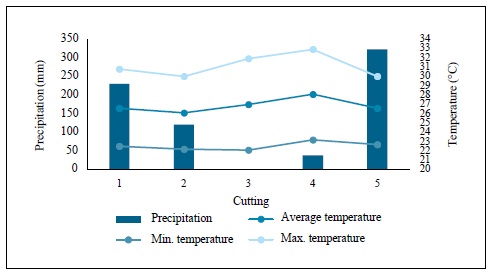
Source: Elaborated by the authors
Figure 1. The behavior of precipitation and temperatures (maximum, average and minimum), during the evaluation period of the Moringa oleifera forage bank in Casanare, Colombia.
Effect on soil quality
A change was found in the initial contents of some minerals in the soil (table 1). Despite the short evaluation time, increases in mineral contents were observed where the M. oleifera forage bank was established. The tendency was to improve the chemical conditions of the soil, increase the bases and enhance its availability to the plants.
Table 1. Soil nutrient content variation before (initial) and after 16 months of the establishment of the Moringa oleifera forage bank, department of Casanare, Colombia
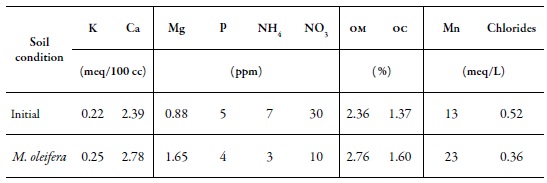
Source: Elaborated by the authors
om: Organic matter; oc: Organic carbon
Furthermore, there was an increase in om, oc, saturable bases and higher water retention capacity in the soil, essential aspects for forage production and adaptation to extreme climatic conditions, agreeing with what was found by Seddaiua et al. (2013) and Rodríguez (2011).
This variation can be explained by the cycling of nutrients carried out by tree species, as these recover nutrients and water from deep soil profiles and places them on top of the ground through litter. These interactions can explain the differences in the initial and final soil conditions. The effect of these systems and their contribution to the recovery and improvement of degraded soils is clear. Vallejo et al. (2012) argue that the entry of organic matter that comes from trees provides substrates for soil microorganisms, increasing their activity and the populations that participate in nutrient recycling.
In this study, the initial condition of the macrofauna in the soil was null (no type of organisms were observed), so the presence of the arboreal species contributed, in the short term, to recover the biological characteristics of the soil (figure 3). In the plots of M. oleifera, the presence of different families of macrofauna (Lumbricidae, Termitidae, Chilopoda, and Scarabaeidae), which have ecological functions in the soil such as pore formation, humification, and mineralization of organic matter was observed. This increase in the macrofauna could also explain the increase of some minerals in the soil, since the micro, meso and edaphic macrofauna contribute to nutrient release, leaving them available for plants. Moreover, this also agrees with Rousseau, Fonteb, Téllez, Van der Hoek and Lavellea (2013) and Sánchez (2007), who found a greater abundance of macrofauna in systems with forage trees. Further, Noguera, Reyes and Mendieta (2017) reported a higher number of individuals and families in M. oleifera plantations with no chemical management compared to conventional management systems.
Production of green fodder anddry matter
The production of edible biomass by forage tree species is influenced by multiple factors, such as climatic conditions, planting density, cutting frequency, cutting height, among others. Under management practices, the forage bank showed an average gf production of 98 t/ha/year and 21.6 t/ ha/year of dm. Statistical differences (p = 0.0084) were found in dm production with higher leaf production (table 2).
Table 2. Average green forage (gf) and dry matter (dm) production per plant fraction of Moringa oleifera in forage banks in the department of Casanare, Colombia
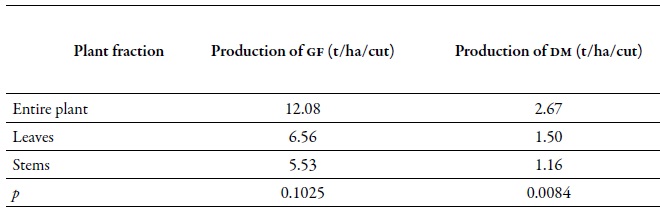
Source: Elaborated by the authors
The production of gf per cut in this study was higher t/ha/cut and 2.93 t/ha/cut; meanwhile Valarezo compared to what has been previously reported by and Ochoa (2013) reported values of 9.33 t/ha/year Díaz (2013), who found productions between 2.48 and 2.04 t/ha/year of gf and dm, respectively.
Moreover, Jarquín and Jarquín (2003) found fresh matter yield values of 81.03 t/ha/year and dm values of 14.44 t/ha/year, due to the higher plant recovery time, as these suffered fewer cuts per year. On the other hand, Padilla, Fraga, Scull, Tuero and Sarduy (2014) found an average dm yield of 2.83 t/ha/cut, similar to what was found in this study, and contrary to what was found by Espinoza and Sevilla (2010), who obtained much higher gf yields (119.2 t/ha/year), which can be attributed to the use of fertilization.
Likewise, Zheng, Zhang and Wu (2016) show fresh matter and dm productions ranging from 43 to 76.4 t/ha/cut and from 1.66 to 12.85 t/ha/cut, respectively, i.e., much higher values compared to those found in this study. These results can be explained by the higher planting densities and, in some treatments, by the lower cutting frequencies used by these authors. The dm yields of M. oleifera vary from 2.6 to 34.0 t/ha/cut depending on the planting density (Foidl et al., 1999, cited by Pérez, Sánchez, Armengol, & Reyes, 2010). Ledea, Rosell, Benítez, Arias and Pérez (2018) documented much higher dm productions to those found in this study (4.2 t//ha/cut and 3.3 t/ha/cut for leaves and stems, respectively), differences that in production can be attributed to the application of organic fertilization and irrigation.
The climatic conditions possibly influenced the productive behavior of M. oleifera, since there were marked periods of lower (cuts 3 and 4) and higher (cuts 1, 2 and 5) precipitation. The productions of gf and dm showed statistical differences (p < 0.0001), finding higher values in cuts preceded by abundant rains; conversely, production was reduced significantly in dry periods (table 3). Despite these climatic conditions, the species produced fodder, which makes it a fodder resource with potential for adaptation strategies to climate change, since, under the same climatic conditions, the grass species have less tolerance to these conditions.
Table 3. Green forage and dry matter (t/ha/cut) biomass production of the entire plant and each fraction (leaf and stem) of Moringa oleifera in forage banks subjected to five cutting session, in the department of Casanare, Colombia
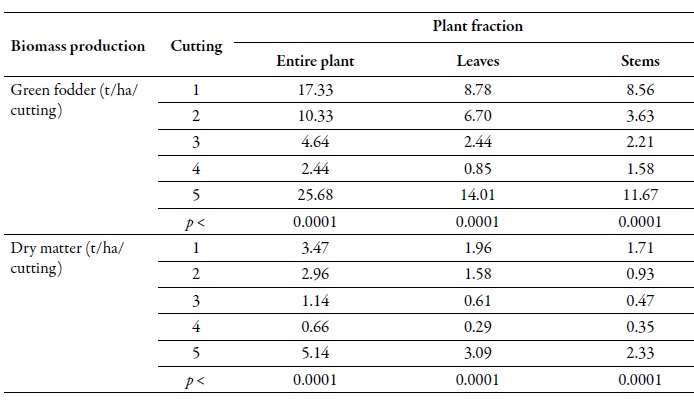
Source: Elaborated by the authors
Precipitation measured during a cutting session: cut 1 = 230 mm; cut 2 = 121 mm; cut 3 = 0 mm; cut 4 = 39 mm; cut 5 = 323 mm.
Padilla et al. (2014) found a similar dm production per cut and affirm that the production in each cut remained stable, attributing the stability to the production of M. oleifera biomass. On the contrary, in this study, considerable differences were observed in production between lower and higher precipitation periods. These results agree with what was reported by Zheng et al. (2016), who evaluated the behavior of the species in drought and rainfall periods, finding a similar behavior to what was found in the current study, although with higher gf and dm production in each season.
Forage production, even in times of drought, can be explained by its thickened tap root system, which allows storing nutrients, water and growth hormones (Casanova et al., 2018).
Nutritional quality of the entire plant and its fractions (leaf and stem)
Table 4 shows the nutritional quality of the entire plant of M. oleifera and its fractions. The nutritional quality of the entire plant was acceptable, especially the percentage of cp, as this species has the potential for animal feed in ecosystems where forage species usually have low cp levels.
Leaves were the plant fraction with the best nutritional quality, presenting higher levels of cp, ivdmd and me, and lower levels of ndf and adf, nutritional characteristics that favor a better use by animals.
Table 4. Nutritional quality of the entire plant and each fraction (leaf and stem) of Moringa oleifera in forage banks, in the department of Casanare, Colombia

Source: Elaborated by the authors
dm: Dry matter; cp: Crude protein; ivdmd: In vitro dry matter digestibility; me: metabolizable energy; ndf: Neutral detergent fiber; adf: Acid detergent fiber; ±: Standard deviation.
Likewise, Padilla et al. (2014) reported similar cp levels to those found in this study during the rainy season, but with percentages higher than 20.8 % in the dry season, meanwhile Díaz (2013), García et al. (2008) and Valarezo and Ochoa (2013), found cp percentages of 22.8 %, 26.6 %, and 22.1 % to 25.5 %, respectively, which can be explained by the nitrogen fertilization they used. Méndez et al. (2018) found 22.8 % and 24.0 % of cp in rainy and not very rainy seasons without fertilization.
Some papers report lower levels of ndf for the entire plant compared to those found in this study. For example, Méndez et al. (2018) report 39.2 %, Díaz (2013) found 41%, and Meza, Olivares, Gutiérrez, Bernal and Aranda (2014) obtained 43.7 % to 50.6 %; meanwhile, Padilla et al. (2014) found similar levels in the entire plant during the rainy season (60.80 %, 56.44 %, and 58.76 %) and lower levels in times of drought (55.3 %, 52.19 %, and 52.95 %).
The adf reported by Meza et al. (2014) was higher compared to what was found in this work, i.e., 35.3 % and 42.4 %, just as what Padilla et al. (2014) found, indicating that in the rainy season, the adf values were 45.89 %, 44.47 % and 44.90 %, meanwhile in the dry season, they documented levels of 38.48 %, 38.68 %, and 32.21 %. Diaz (2013), on the contrary, reported lower levels (27.84 %) than those found in this work, although they used nitrogen fertilization; likewise, Méndez et al. (2018) found lower levels but without fertilization or irrigation (22.5 %).
The leaf: stem ratio in forage plants is a valuable indicator since the most substantial amount of nutrients is concentrated in the leaves; therefore, higher production of this fraction (better ratio) has positive effects on animal production systems, by providing higher amounts of nutrients. The leaf: stem ratio in this study was on average 1.4:1, finding statistical differences (p < 0.0001) between cuts, possibly due to climatic conditions (table 5). In the fourth cut the relation is negative, possibly because the plants suffered a prolonged drought period, and as a homeostatic mechanism in the face of water stress, it stimulates the fall of leaves to reduce water losses. Besides, in the third cut, despite corresponding to a period in which there was no precipitation (drought), the leaf: stem ratio was not affected in comparison to the rainy season. The higher resistance that the arboreal species show in dry periods can explain the above, due to the length of their roots that allows them to explore greater depths of the soil, taking water from deeper profiles, in comparison with herbaceous species.
Table 5. Percentage of each fraction of the plant and leaf: stem ratio of Moringa oleifera plants in forage banks subjected to five cutting sessions, department of Casanare, Colombia
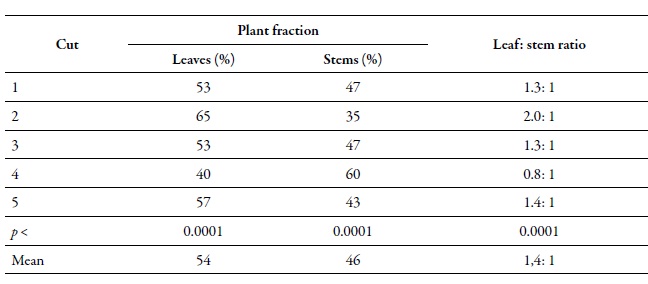
Source: Elaborated by the authors
Precipitation: cut 1 = 230 mm; cut 2 = 121 mm; cut 3 = 0 mm; cut 4 = 39 mm; cut 5 = 323 mm.
Meza et al. (2014) report leaf: stem ratios from 1.7: 1 to 2.4: 1, and attribute the reduction in the ratio to climatic factors such as temperature, as it decreases at higher temperatures. Padilla et al. (2014) did not find differences in the number of leaves/plant when cuts were made at different heights. Conversely, Ledea et al. (2018) found statistical differences in the percentage of leaves (62.7 %) and stems (37.3 %), with higher leaf production compared to what was found in this study.
In the holistic analysis of the system, the loss of leaves should be understood as a positive aspect, since it is a mechanism through which the recycling of nutrients is favored, and it contributes to recover or maintain soil properties.
Conclusions
The performance analysis of M. oleifera showed an important effect in the recovery of degraded soils and the production of green forage and dry matter of good nutritional quality. Despite decreasing forage production in periods of lower rainfall, the species withstands drought conditions; in these periods, the leaf: stem ratio is also reduced due to the fall of leaves to the soil, which favors the recycling of nutrients. Given its performance, M. oleifera is considered as an alternative for strategic supplementation in livestock systems in tropical humid forest ecosystems.
REFERENCES
Alvear, C., & Apráez, J. (2013). Caracterización botánica, nutricional y fenológica de especies arbóreas y arbustivas de uso potencial para sistemas silvopastoriles en la zona de bosque muy seco tropical del norte de Nariño y sur del Cauca. Agroforestería Neotropical, 3, 37-46. [ Links ]
Borroto, A., Negrín, A., Peña, P., & Vega, D. (2018). Uso de Moringa (Moringa oleifera) para ovinos en crecimiento. Como alternativa alimentaria ambientalmente amigable. Universidad & Ciencia, 7(3), 78-90. Recuperado de https://www.revistas.unica.cu/index.php/uciencia/article/view/818/1252 [ Links ]
Casanova, F., Cetzal, W., Díaz, V., Chay, A., Oros, I., Piñeiro, A., & González, N. (2018). Moringa oleifera Lam. (Moringaceae): Árbol exótico con gran potencial para la ganadería ecológica en el trópico. Agroproductividad, 11(2), 100-105. Recuperado de https://www.researchgate.net/publication/323738344_Moringa_oleifera_Lam_Moringaceae_arbol_exotico_con_gran_potencial_para_la_ganaderia_ecologica_en_el_tropico [ Links ]
Díaz, C. (2013). Efecto de la fertilización nitrogenada y la densidad de siembra sobre la producción de biomasa y composición química del Marango (Moringa oleifera) en suelo arcilloso de Juigalpa, Chontales (tesis de grado). Universidad Nacional Agraria, Managua, Nicaragua. Recuperado de https://www.repositorio.una.edu.ni/3264/1/tnf04d542e.pdf. [ Links ]
Espinoza, J. R., & Sevilla, S. L. (2010). Efecto de la densidad de siembra y nivel de fertilización nitrogenada sobre el rendimiento de Moringa oleifera en suelo franco arcilloso (tesis de grado). Universidad Nacional Agraria, Managua, Nicaragua. Recuperado de https://www.repositorio.una.edu.ni/1409/. [ Links ]
García, D., Medina, G., Cova, J., Torres, A., Soca, M., Pizzani,P., ... Domínguez, E. (2008). Preferencia de vacunos por el follaje de doce especies con potencial para sistemas agrosilvopastoriles en el Estado Trujillo, Venezuela. Pastos y Forrajes, 31(3), 255270.Recuperado de https://www.scielo.sld.cu/scielo.php?script=sci_arttext&pid=S0864-03942008000300006 [ Links ]
Giraldo, O. (2008). Seguridad alimentaria y producción pecuaria campesina: el caso de la localidad rural de sumapaz. Revista Luna Azul, 27, 49-59. [ Links ]
Jarquín, J. M., & Jarquín, M. H. (2003). Producción de biomasa de Moringa oleifera bajo diferentes densidades de siembra y frecuencias de corte en el trópico seco de Nicaragua (tesis de grado). Universidad Nacional Agraria, Managua, Nicaragua. Recuperado de https://www.repositorio.una.edu.ni/1294/ [ Links ]
Ledea, J., Rosell, G., Benítez, D., Arias, R., & Pérez, Y. (2018). Estructura y rendimiento forrajero de Moringa oleifera cv Nicaragua en diferentes frecuencias de corte. Revista de Producción Animal, 30(3), 13-21. Recuperado de https://www.scielo.sld.cu/scielo.php?script=sci_arttext&pid=S2224-79202018000300003 [ Links ]
Méndez, Y., Suárez, F., Verdecia, D., Herrera, R., Labranda, J., Murillo, B., & Ramírez, J. (2018). Bromatological characterization of Moringa oleifera foliage in different development stages. Cuban Journal of Agricultural Science, 52(t3), 1-10. Recuperado de https://www.cjascience.com/index.php/CJAS/article/view/809/813 [ Links ]
Meza, C., Olivares, E., Gutiérrez, E., Bernal, H., & Aranda, J. (2014). Evaluación de la moringa (Moringa oleifera L.) Como alternativa forrajera de alto contenido nutricional para las partes bajas del estado de Nuevo León (tesis de grado). Universidad Autónoma de Nuevo León, Nuevo León, México. Recuperado de https://www.nanopdf.com/download/anu305-25-2014-05-1_pdf. [ Links ]
Nahed, J., Sanchez, B., Mena, Y., Ruiz, J., Aguilar, R., Castel, J., ... Delgadillo, C. (2013). Feasibility of converting agrosilvopastoral systems of dairy cattle to the organic production model in southeastern Mexico. Journal of Cleaner Production, 43, 136-145. doi:10.1016/j. jclepro.2012.12.019. [ Links ]
Noguera, A., Reyes, N., & Mendieta, B. (2017). Diversidad y distribución de la macrofauna edáfica en dos sistemas de manejo de Moringa oleifera (Lam.): relación con las propiedades del suelo. Revista La Calera, 17(29), 78-86. doi:10.5377/calera.v17i29.6528. [ Links ]
Padilla, C., Fraga, N., Scull, I., Tuero, R., & Sarduy, L. (2014). Efecto de la altura de corte en indicadores de la producción de forraje de Moringa oleifera cv. Plain. Revista Cubana de Ciencia Agrícola, 48(4), 405-409. Recuperado de https://www.redalyc.org/pdf/1930/193033033016.pdf. [ Links ]
Pérez, A., Sánchez, T., Armengol, N., & Reyes, F. (2010). Características y potencialidades de Moringa oleifera, Lamark. Una alternativa para la alimentación animal. Revista Pastos y Forrajes, 33(4), 1-16. Recuperado de https://www.scielo.sld.cu/scielo.php?script=sci_arttext&pid=S0864-03942010000400001 [ Links ]
Rivera, L., Armbrechta, I., & Calle, Z. (2013). Silvopastoral systems and ant diversity conservation in a cattle-dominated landscape of the Colombian Andes. Agriculture, Ecosystems and Environment, 181, 188-194. doi:10.1016/j.agee.2013.09.011 [ Links ]
Rodríguez, F. (2011). Efecto de los árboles aislados sobre características del suelo en sistemas silvopastoriles en Rivas, Nicaragua (tesis de maestría). Centro Agronómico Tropical de Investigación y Enseñanza (catie), Turrialba, Costa Rica. [ Links ]
Rousseaua, L., Fonteb, S., Téllez, O., Van der Hoek, R., & Lavellea, P. (2013). Soil macrofauna as indicators of soil quality and land use impacts in smallholder agroecosystems of western Nicaragua. Ecological Indicators, 27, 71-82. doi:10.1016/j.ecolind.2012.11.020 [ Links ]
Sánchez, S. (2007). Acumulación y descomposición de la hojarasca en un pastizal de Panicum maximum Jacq. y en un sistema silvopastoril de P. maximum y Leucaena leucocephala (Lam.) de Wit (tesis de doctorado). Instituto de Ciencia Animal, La Habana, Cuba. [ Links ]
Seddaiua, G., Porcua, G., Leddaa, L., Roggeroa, P., Agnellib, A., & Cortic, G. (2013). Soil organic matter content and composition as influenced by soil management in a semi-arid Mediterranean agro-silvo-pastoral system. Agriculture, Ecosystems and Environment, 167, 1-11. doi:10.1016/j.agee.2013.01.002. [ Links ]
Tafur, O., Hurtado, E., Morales, J., Fajardo, D., Murgueitio, E., & Solarte, A. (2010). Sistemas silvopastoriles para producción de leche en el piedemonte amazónico de Colombia sin incremento de la deforestación. En M. Ibrahim & E. Murgueitio (Eds.), Resúmenes VI Congreso Latinoamericano de Agroforestería para la producción pecuaria sostenible. Multiplicación de los sistemas agroforestales y silvopastoriles para la adaptación y mitigación del cambio climático en territorios ganaderos. Turialba, Costa Rica: Centro Agronómico Tropical de Investigación y Enseñanza (CATIE). [ Links ]
Valarezo, J., & Ochoa, D. (2013). Rendimiento y valoración nutritiva de especies forrajeras arbustivas establecidas en bancos de proteína, en el sur de la Amazonía ecuatoriana. Cedamaz, 3, 113-124. [ Links ]
Vallejo, V., Roldán, F., Arbeli, Z., Terán, W., Lorenz, N., & Dick, R. (2012). Effect of land management and Prosopis juliflora (Sw.) DC trees on soil microbial community and enzymatic activities in silvopastoral systems of Colombia. Agriculture, Ecosystems & Environment, 150, 139-148. doi:10.1016/j.agee.2012.01.022 [ Links ]
Velarde, L. (2012). Evaluación de la percepción y los factores determinantes en la implementación de medidas de adaptación al cambio y variabilidad climática por los productores de leche de la cuenca del río La Villa, Panamá (tesis de maestría). Centro Agronómico Tropical de Investigación y Enseñanza (catie), Turrialba, Costa Rica. [ Links ]
Villanueva, C., Ibrahim, M., Casasola, F., Ríos, N., & Sepúlveda, C. (2009). Sistemas silvopastoriles: una herramienta para la adaptación al cambio climático de las fincas ganaderas en América Central. En C. Sepúlveda & M. Ibrahim (Eds.), Políticas y sistemas de incentivos para el fomento y adopción de buenas prácticas agrícolas como una medida de adaptación al cambio climático en América Central (pp. 103-125). Turrialba, Costa Rica: catie. Recuperado de https://www.sidalc.net/repdoc/a3825e/a3825e.pdf [ Links ]
Zheng, Y., Zhang, Y., & Wu, J. (2016). Yield and quality of Moringa oleifera under different planting densities and cutting heights in southwest China. Industrial Crops and Products, 91, 88-96. doi:10.1016/j.indcrop.2016.06.032. [ Links ]
Acknowledgments
The authors wish to thank Universidad de La Salle for financing this study.
Received: July 10, 2018; Accepted: February 14, 2019











 texto em
texto em 


